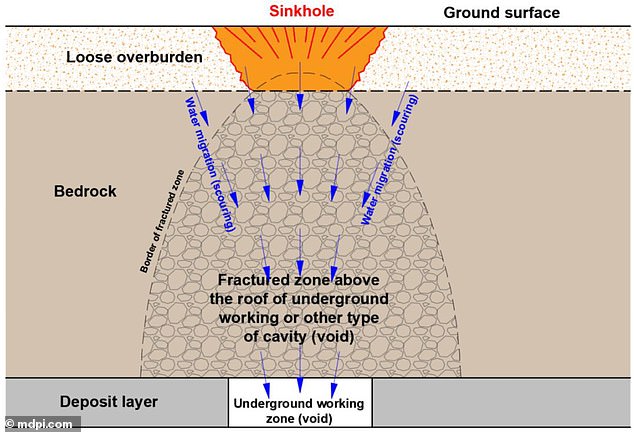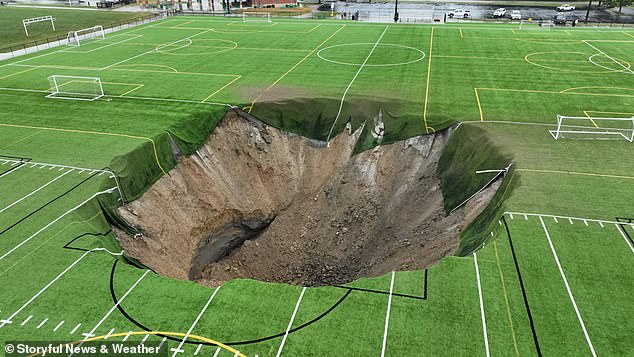What causes sinkholes? Experts say huge voids forming in the ground are becoming more common — like a 100-foot-wide void on a football field in Illinois
This week, shocking footage emerged of a massive sinkhole in a football field in Illinois.
The hole, estimated to be 100 feet (30 meters) wide and 30 feet (9 meters) deep, appeared without warning and engulfed a string of spotlights, the footage shows.
Fortunately, no one was injured, but experts warn that these kinds of dramatic sinkhole formations could become more common in the future.
Sinkholes range in diameter from a few meters to huge, gaping chasms. They are usually a natural phenomenon, but can also be caused by human activities, such as mining.
According to Peter Styles, professor of environmental geophysics at Keele University, the Illinois oil field is likely built on abandoned mine shafts or “mining pits.”
The massive sinkhole suddenly opened up Wednesday morning at Gordon Moore Park in Alton, Illinois, though thankfully no injuries were reported.
‘When you excavate rock to extract limestone, coal or other minerals, the spaces and tunnels are known as workings,’ he told MailOnline.
‘People think they can build playing fields instead of old grounds.
‘It costs money to restore it and they may claim that these are historic structures and that they have not collapsed so far and are stable – but that’s not necessarily how geology works.
‘You can imagine that it would be a disaster if this happened under occupied buildings.’
According to the academic, the series of fields in Gordon Moore Park, Alton, Illinois, would likely have been “precariously balanced” on a relatively thin layer of rock covering the hole.
“The very abrupt collapse we see in the amazing video suggests there was a dangerous balance,” Professor Styles said.
“Sometimes a heavy rainfall can be enough to cause an eventual collapse or even a tremor of a small earthquake somewhere in the region.”

Subsidence varies from a few meters in diameter to huge, gaping chasms and is usually a natural phenomenon, but can also be caused by human processes such as mining.

The shocking moment a sinkhole opened on an Illinois football field was captured on surveillance camera, swallowing a bank of spotlights
Experts from the British Geological Survey (BGS) agreed that this was probably a man-made collapse of a limestone mine, rather than a natural sinkhole caused by the breakdown of soluble rock by rainwater.
A BGS spokesperson told MailOnline that the town of Alton, Illinois has a legacy of old limestone and coal mines, but this could even be an active mine.
“Similarly, sinkholes can also develop after a mine is abandoned as water levels rise,” they said.
However, the BGS spokesperson declined to comment on the cause of the sudden collapse.
Unfortunately, sinkholes may become more common in the near future as they are associated with heavier rainfall – a symptom of climate change.
Warmer air can hold more water. As a result, rainfall worldwide increases on average as global warming increases.

Experts from the British Geological Survey (BGS) agreed that this was probably a man-made collapse of a limestone mine
Heavy rainfall, flooding and leaking infrastructure are known trigger mechanisms for both natural and ‘anthropogenic’ (human-caused) sinkholes, BGS said.
‘Climate change means there is more rainfall in winter and summers are warmer and drier, with a greater risk of severe storms.
‘(This) means that we are likely to have periods of increased sinkhole activity in the future – both natural subsidence, but also the collapse of old mines and mine shafts and underground infrastructure.’
It follows giant sinkholes that have opened in the past year in Arizona, Sydney and California, as well as in England near an HS2 construction site.
